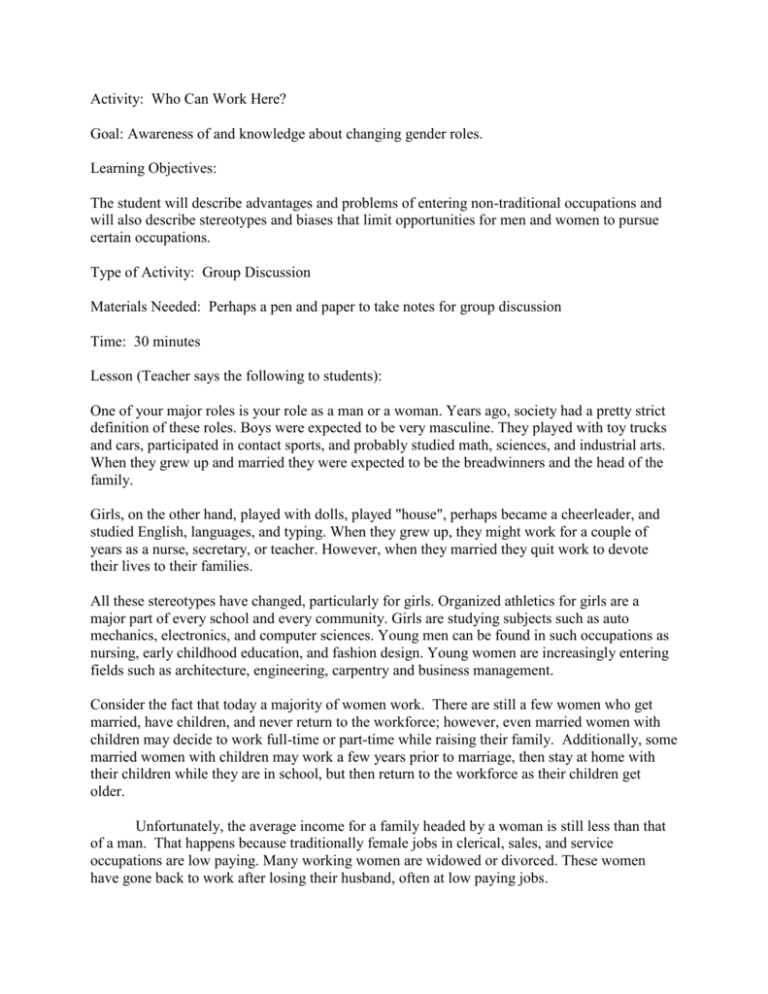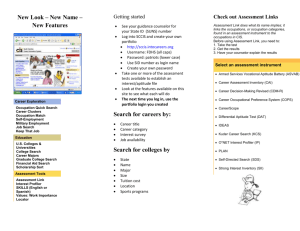Busting Gender Stereotypes Activity
advertisement

Activity: Who Can Work Here? Goal: Awareness of and knowledge about changing gender roles. Learning Objectives: The student will describe advantages and problems of entering non-traditional occupations and will also describe stereotypes and biases that limit opportunities for men and women to pursue certain occupations. Type of Activity: Group Discussion Materials Needed: Perhaps a pen and paper to take notes for group discussion Time: 30 minutes Lesson (Teacher says the following to students): One of your major roles is your role as a man or a woman. Years ago, society had a pretty strict definition of these roles. Boys were expected to be very masculine. They played with toy trucks and cars, participated in contact sports, and probably studied math, sciences, and industrial arts. When they grew up and married they were expected to be the breadwinners and the head of the family. Girls, on the other hand, played with dolls, played "house", perhaps became a cheerleader, and studied English, languages, and typing. When they grew up, they might work for a couple of years as a nurse, secretary, or teacher. However, when they married they quit work to devote their lives to their families. All these stereotypes have changed, particularly for girls. Organized athletics for girls are a major part of every school and every community. Girls are studying subjects such as auto mechanics, electronics, and computer sciences. Young men can be found in such occupations as nursing, early childhood education, and fashion design. Young women are increasingly entering fields such as architecture, engineering, carpentry and business management. Consider the fact that today a majority of women work. There are still a few women who get married, have children, and never return to the workforce; however, even married women with children may decide to work full-time or part-time while raising their family. Additionally, some married women with children may work a few years prior to marriage, then stay at home with their children while they are in school, but then return to the workforce as their children get older. Unfortunately, the average income for a family headed by a woman is still less than that of a man. That happens because traditionally female jobs in clerical, sales, and service occupations are low paying. Many working women are widowed or divorced. These women have gone back to work after losing their husband, often at low paying jobs. Remember, all careers are open to both sexes. You are not confined to a particular career simply because of your gender being male or female. “What is important is your interests and abilities, not your sex" (Collins, Marv et al., 1985, pg 69). Activity: Discuss the background information with the students. Have students brainstorm completions to the following statements: (a) Girls are often encouraged to enter occupations such as ____________________ (a nurse, a secretary, a nursery school teacher, etc.). (b) Boys are often encouraged to enter occupations such as ____________________ (an engineer, a truck driver, a dentist, etc.). Discuss these statements and point out that beliefs about sex roles do influence career decisions. Discuss the meaning of sex-role stereotyping. Make sure that students understand that general assumptions about the nature, characteristics, and capabilities of men and women, particularly when they are stated in terms of `Men are ...' or `Women are ...' are examples of stereotyping. (a) Discuss the following statements with the class: Men should be bus drivers. Women should be secretaries. Women are weak and are only capable of doing light work. Men are strong and should therefore be responsible for heavy work. (b) Ask students whether they agree or disagree with these statements and why. Discuss the limiting effects of sex-role stereotyping on career decisions. Ask for reactions to the notion of women and men in `non-traditional' careers. You may also ask the following questions: 1. What are some of the jobs traditionally done by women and by men? 2. For what reasons are women concentrated in certain occupational fields and men in others? 3. How do you feel about men becoming nurses, kindergarten teachers, or secretaries and women becoming bus drivers, construction workers, or engineers? 4. Are men and women capable of doing the same work? Discuss the reasons behind the answers. 5. What are some of the fears that both men and women have when they select nontraditional careers? Ask students to think about reasons for considering or not considering non-traditional careers for themselves. Ask for volunteers to share their reasons with the class. Ensure that students understand that individuals can lead satisfying and productive lives whether they choose traditional or non-traditional careers. Discuss the impact of sex-role stereotyping on both boys and girls. Ensure students understand that such stereotyping creates unnatural barriers to the achievement of maximum potential for both men and women. Using a show of hands, have students answer Yes or No to the following questions and record the answers on the board. (a) Should women who have children work outside the home? (b) Should men and women share equally in such household chores as doing the laundry, painting, preparing meals, looking after children, cleaning, and mowing the lawn? (c) Do most men like having their wives work outside the home? (d) Do most women work so they can buy `extras' for themselves, their homes, and their families? (e) Does everyone want to get married some day? (f) Should men earn more money than women? (g) Should everyone - man or woman - be allowed to do whatever kind of work he/she chooses? (h) Do men and women work for the same reasons? Place students in groups, by gender, to discuss the questions and the survey results. As a class, determine then discuss reasons for any differences in the opinions of the boys and the girls. Discuss the impact of the attitudes presented by the questions and the student responses to them on the achievement of potential and the full exploration of self. Again, have students think about reasons for considering or not considering non-traditional careers for themselves. Ask for volunteers to share their reasons with the class. Ensure that students understand that individuals can lead satisfying and productive lives whether they choose traditional or non-traditional careers. Culture and Sex-Role Stereotyping – Discuss with students the differences in gender roles between various cultures. Students should understand that the definitions of male and female roles are culturally determined. Language and Sex-Role Stereotyping - Ask students to investigate changes in the language used to describe certain occupations or achievements. Discuss the positive effects that the changes would have on career decisions (e.g., chairman - chair or chairperson). Help students examine changes in the language used to describe certain occupations or achievements. Examples of such changes include: fireman is now a firefighter steward, stewardess is now a flight attendant policeman, policewoman is now a police officer mailman, postman is now a letter carrier or postal worker delivery boy is now a messenger or courier man's achievement is now human achievement manpower is now human resources or labor force businessman's lunch is now a business lunch man-made is now manufactured, machine made, or handmade the best man for the job is now the best person for the job Sources: One step at a time, Educational and Career Explorations, Intermediate Division, Ministry of Education, Ontario, 1984. Junior high school career guidance, New Brunswick Department of Education, 1988. *This lesson was found online and was modified slightly for purposes of this career workshop.






